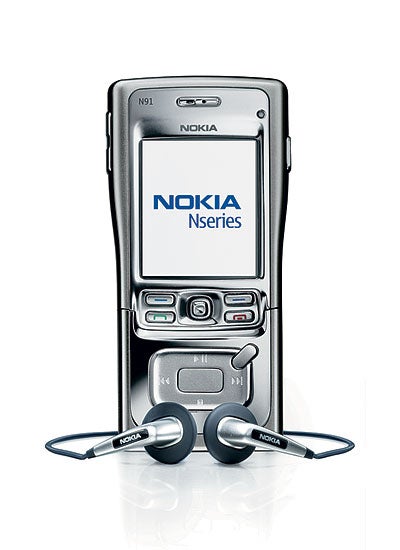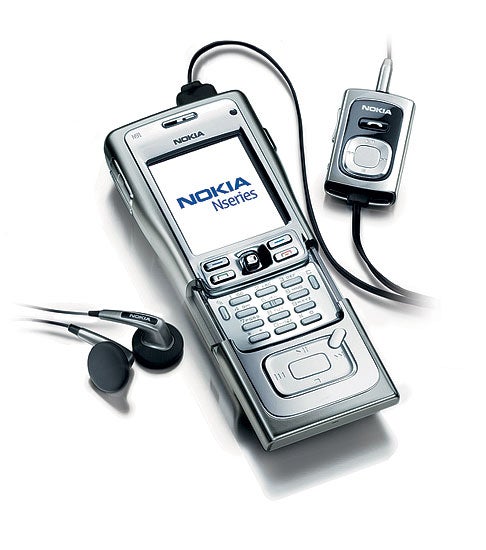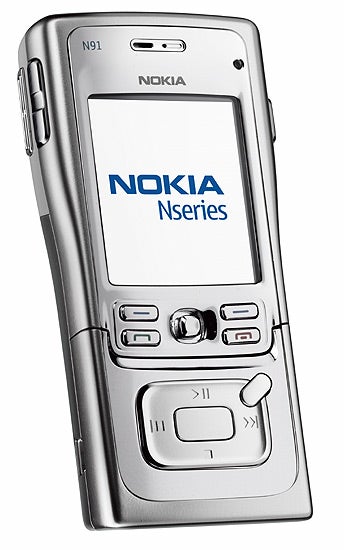Nokia N91 4GB Mobile Phone Review
Nokia N91 4GB Mobile Phone
Nokia's 4GB N91 music phone has been a long time coming. Is it worth the wait?

Verdict
If you feel you’ve been waiting ages for Nokia’s N91, you are right. The press release I have on file announcing the handset is dated 27 April 2005. In that document, worldwide availability is stated as expected by the end of that year. Well, it is now May 2006, and only now has the handset finally turned up. It’s complete with the 4GB of storage promised way back then – an amount that has not been bettered by any other handset in the interim, though Samsung’s SGH i300 Windows Mobile handset got close with 3GB.
Was it worth the wait? Does the N91 succeed in marrying the needs of the mobile phone user and the music listener? We’re about to find out.
Your first thoughts when you get hold of the N91, or see it in a shop window are likely to be about its size and general looks. With an all over silver chrome fascia, the N91 is fatter at the top than at the bottom, giving it a bulging appearance, though this doesn’t negatively affect how it feels in the hand. 
At 113 mm tall, 55 mm wide and 22mm deep the N91 is a lot bigger than many phones, and actually rivals Orange’s SPV M600 for overall size. The bottom third of the casing is taken up with a series of controllers for music playback, and you need to slide this down to get to the number pad. When you do this, the handset grows to a huge 140mm tall.
The good news is that you can do most things without needing to use the slider, and when you do need the number pad its small wide keys are nicely raised from their surround, responsive, and very easy to hit.
That front fascia is one of several aspects of both software and hardware designed to emphasise the musicality of this handset: Nokia certainly does seem to have covered the bases and thought user needs through well.
The shortcuts on the fascia are effectively built as a large navigation button, and doing what you want (play/pause, back, forward, stop) is very easy. An off-centre lozenge shaped button acts as a shortcut to the music player software. On the top edge of the N91 is a slider that locks and unlocks all the keys.
There are three ways to connect the N91 to a PC for file transfer. This is a Series 60 handset (it actually runs the latest, third edition, of the Symbian software), and has built in contacts, diary and to do list software which can be synchronised using Nokia’s PC Suite.
If you want to synchronise music then you can opt for ‘Media Player’ mode, and the N91 will show up as a device you can synchronise with Windows Media Player 10. If you don’t feel any affinity towards Windows Media Player 10, or don’t actually want to synch music, then you can simply treat the N91 as a mass storage device and drag and drop or copy files from your hard drive.
All three connection types are made using the provided USB cable, which, thank the Lord, is not proprietary at the handset end, but mini USB. You simply choose your preferred connection method from a list that pops up when you make the link. 
There is more good news when it comes to music playback and headsets. Nokia provides a two-piece headset. At the handset end a 3.5mm port is used to connect a section with inline controls and voice call microphone. A 3.5mm connector from this goes to the provided earbuds. This means you can substitute your own cans for those Nokia provides and still, if you want to, have the inline controls. There is a ‘but’, though. You need to use the Nokia headset to listen to the built in FM radio as the antenna is located within it. It supports Visual Radio, but that’s still not actually working in the UK at the moment.
You don’t get stereo playback from the handset speaker itself, which some might find a tad annoying. But there is plenty of volume and I found it fine for listening to with the handset sitting on a desk. In fact, while playing music continuously to see how long the battery could stand up for I had to put the N91 into a drawer to muffle it while on the (other) phone – it is that loud!
During the battery test I set the power save time out set to the maximum available which is 30 minutes, the light time out to the maximum available which is 60 seconds, the screen brightness to highest available and the music player volume at its highest. Playback was through the loudspeaker. The battery delivered a rather good eight hours and 12 minutes of music. Nokia suggests you should get ten hours of playback, and you should be able to achieve this or close to it by using different power save and light time out settings.
Music playback stops when you take a voice call on the N91, and starts again from where it left off when you hang up. Plenty of file formats are supported, among them AAC, MP3, WAV and WMA. There is DRM support if you are into that kind of thing.
All in all, I’m pretty pleased with the way Nokia has thought about, and then serviced, the needs of music listeners. None of what’s been done is rocket science, but it all helps with ease of use.
The N91 is a tri-band 3G handset, and one of the features that may well irritate some people is the absence of a front facing camera for making video calls.
It is very unusual to see Wi-Fi in a handset, but it is here, and it is the faster 802.11g standard at that. Using it is easy. When you make a connection, such as to use the Web browser, you are asked to choose an access point. This could be via your SIM or a WLAN router. It is most likely you’ll use your LAN for Internet browsing. You can’t synchronise, file share, or stream over WLAN.
The Web browser is disappointing. It doesn’t force pages into the screen width, so there’s often a lot of horizontal scrolling to be done. I know that Web pages aren’t designed for 176 x 208 pixel screens, but on the other hand, horizontal scrolling on a small screen is, putting it mildly, a nuisance.
The browser redeems itself by offering a miniaturised view of an entire Web page and allowing you to choose an area to zoom into, which makes general navigation a bit easier, and by offering a mini cursor which makes pinpointing links easy, but scrolling madly left and right to read a TrustedReviews review, for example, is no fun at all.
The camera is a two Megapixel job, and, very unusually, it lacks a hardware based shortcut button. To get it rolling you need to choose it from the main menu area – which you get to from a dedicated side button. Thereafter the softmenus and mini joystick that sits under the screen provide all the necessary control. The mini joystick is well made and solid.
Other on board software goodies apart from those already mentioned include a voice recorder, the Flash player, Real Player, Nokia’s IM client, Push to Talk, alarm clock, text notes tool, and Nokia’s LifeBlog software. The Active Standby shows small icons for the last six applications you’ve opened as well as calendar entries. Bluetooth, it almost goes without saying, is also here.
”’Verdict”’
For music fans, the N91 does appear to have been worth the wait. In the year between announcement and arrival nobody has come up with a music playing handset with more internal storage, and the ease of file transfer and user friendly hardware and software are to be praised.
But while the music specs are pretty good, corners have been cut elsewhere. Why is the camera not higher resolution? Why isn’t there a front facing camera for 3G video calls? Why does the N91 have only a 176 x 208 pixel screen, when Nokia’s new N80 offers 352 x 416 pixels? Why is there no support for external memory expansion? I know 4GB should be enough for everyone, but despite the various connectivity outlined above, there’s nothing like a flash memory card reader for quickly moving files. And it’s a shame the N91 is such a giant.
How we test phones
We test every mobile phone we review thoroughly. We use industry standard tests to compare features properly and we use the phone as our main device over the review period. We’ll always tell you what we find and we never, ever, accept money to review a product.
Trusted Score
Score in detail
-
Usability 8
-
Value 8
-
Features 8

